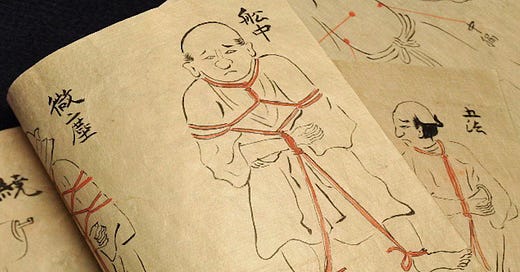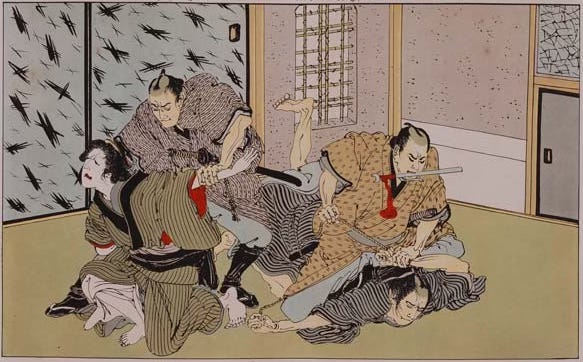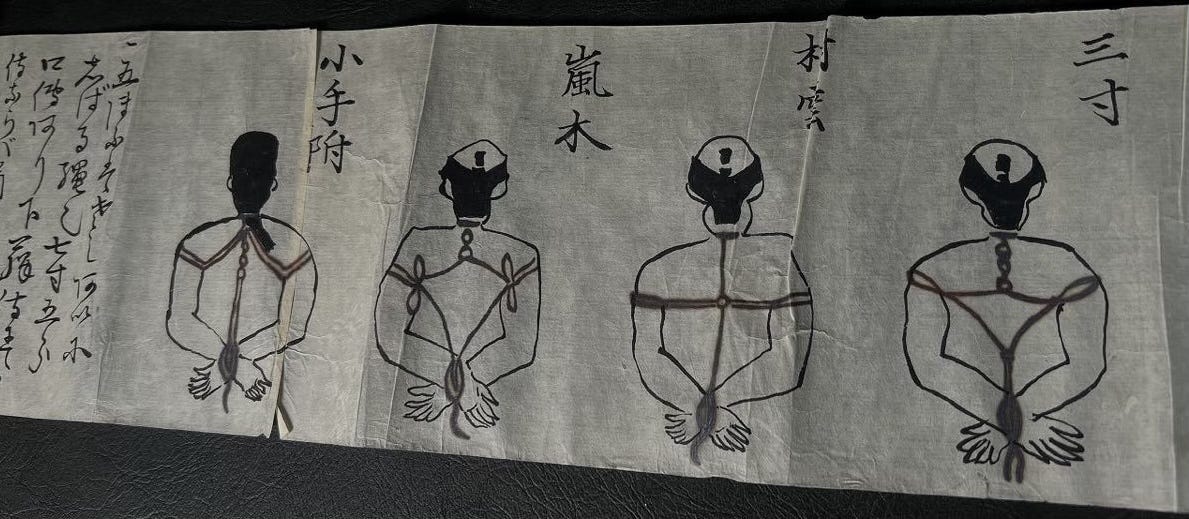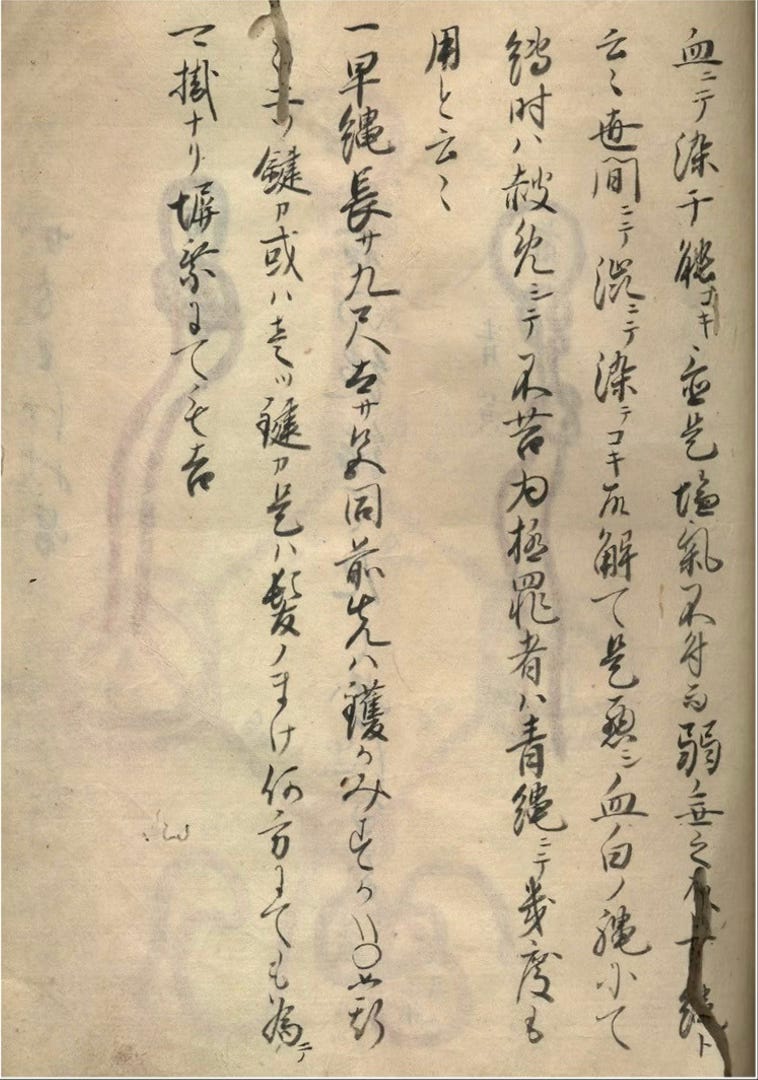Hojojutsu
A Unique Samurai Law Enforcement System for Capturing, Binding and Restraining an Opponent With Rope or Cord.
Hojojutsu 捕縄術 literally, “rope-binding techniques”, also known as Torinawajutsu 捕縄術, restraining rope techniques, and simply as Nawajutsu 縄術, or rope techniques, is a unique samurai martial and law enforcement rope tying system for capturing, binding and restraining an opponent with rope or cord.
During the Edo period, before the introduction of modern handcuffs, there were over 150 schools with numerous cord tying styles and tactics, and the arts were widely used as part of the constabulary’s arrest and restraining techniques. These schools of the rope binding arts were passed down in various regions and were actively taught by most police organizations even after the 1868 Meiji Restoration, however, since the widespread use of modern handcuffs during the Showa period, (1925-1989) the art was deemed unnecessary, and although the basics are taught to modern day police officers, is no longer included in the subjects of arrest techniques. As such, many of the techniques have been lost
Edo period law-enforcement officers called Yoriki and in particular Doshin carried a torinawa or capture-rope, a small, specially wound cord, easily carried and deployed easily, as it quickly unwound as the bundled end of the cord was passed around the arrested person’s body, neck and arms. So effective were the methods that this could be performed by a single lawman while the prisoner was actively resisting and had to be restrained quickly. For the capture and restraint of a prisoner a hayanawa, 早縄 or fast rope, a strong, thin cord with a diameter of around 3–4 millimetres and sometimes the sageo, the cord attached to the saya, or scabbard of a samurai’s sword was used.
Whereas most constraints around the world and throughout history concentrated simply on the effectiveness, in typical Japanese style, visual and aesthetic details were also considered. These Japanese rope binding techniques were not just effective at confining a prisoner but also showed a certain artistic flair, and importantly a deep understanding of human anatomy and physics, introducing such techniques as where limbs are tied in positions that decrease the forces generated, or those where constricting cords looped around the neck and limbs put pressure on blood vessels and nerves numbing the extremities, discouraging the captured person from struggling.
The techniques are broadly divided into Hayanawa methods for the quick restraint of a captured enemy, and Honnawa for formal or ceremonial use, and methods for inflicting torture with the tied ropes. The thickness, length, and material of the rope used varied greatly depending on the school and purpose. Incidentally, the Edo Magistrate's Office changed the colour of the rope with each season.
Hayanawa
Hayanawa incorporates not only techniques for restraining an opponent after subduing them with Jujutsu or Jujitsu, but also various combat techniques that use the rope as a weapon. In order to make a quick restraint, iron rings or hooks were often attached to the rope. Honnawa methods were mainly used when escorting or presenting criminals to the magistrates, and different methods of tying are prepared depending on the status and occupation of the arrested, their gender, and their crime. For example, a person accused of — but not yet convicted — of a crime would be inclosed using methods which securely constrained them, but without securing knots. Instead of tying knots, the arresting officer or Doshin held on to the rope from behind the prisoner, keeping them under control. In such a case, the ropes were not tied to prevent the prisoner from suffering the shame of being publicly restrained.
The other style used one, and occasionally two honnawa ropes, which, like the hayanawa, came in different lengths, but was usually made of hemp and averaged a diameter of six millimetres or more, and as long as 25 meters. This provided more secure binding than the hayanawa styles, making it ideal for restraining criminals requiring restraint at judicial hearings, being taken to prison, of for ensuring the prisoner was securely held for public display prior to execution.
Honnawa
Honnawa styled binding techniques were often tied by a small group of warriors or constables at once, allowing for more intricate, ornate and artistic roping patterns than could be achieved with hayanawa. Both forms provided effective restraint with a distinct visual aesthetic.
There are currently almost no classical horowajutsu schools remaining, only martial arts schools where the techniques are taught in conjunction with jujitsu grappling and jojutsu, the art of the staff, to the degree that many of the traditional methods have been partially lost. The traditional martial Koryu schools maintaining the art of bondage include Bo Ryu, Koden Enshin Ryu Iaijutsu, Kurokawa Ryu Ninjutsu, Kuruma Yoshin Ryu Jujutsu, Seigo Ryu Jujutsu, Seishin Ryu Jujutsu, Nanbu Handen Hojo Jutsu, Nagano Ryu Heihou, Mitsuo Muteki Ryu, and Tenfu Muso Ryu. These traditional techniques maintained by these schools and the methods of tying are rarely demonstrated outside Japan.
Blood Ropes of Aichi
The best restraining ropes were made from hemp fibres which have been pounded soft. Ropes braided with three thin strands are said to be best. After it is braided, rope dyed with blood, called Ketsu Some in Japanese, is considered to be the best. The reason is because it is long-lasting because the salt in blood prevents it from rotting. In addition, bovine blood-dyed ropes are very easy to tie. Ropes dyed with astringent dyes tend to rot quickly and can come undone easily. Ropes made of silk are strong and easy to tie, however the knots come untied easily. In the Edo Era the most highly prized rope was made at Sanshu Hozo Temple, located in modern day Aichi Prefecture, and believed to be where a young Tokugawa Ieyasu was taught to read and write. This temple was founded in the year 701 by the monk Gyoki 行基 (668-749.)
Fujita Seiko (1898- 1966) was a martial arts researcher and Koka Ryu Ninjutsu master whose written works included Zukai Torinawajutsu, and particularly the excellent Fukai Torinawa (Hojo) Jutsu 図解捕縄術An Illustrated Guide to Samurai Bondage, which are considered the bibles of the rope arts, and featured hundreds of knots and binds from many different schools.
The many different styles and techniques, lengths and materials, and many different schools of hojojutsu, promoting many different effective ways to rope tie an opponent or person under arrest is a quintessentially Japanese art that is a unique product of samurai history and culture.










Hi Joao San, ...Hmm, that movie,...It had good and bad points, and although I've only seen it twice, the historical mistakes and the fictional points far outweighed the good. Some of the performances were good, and the scale was admirable, but the story....HUH?? Ninja women? Shima Sakon blowing himself up at the end? The use of battle axes and crossbows? (What country did the director think this was set in?) ....I left the theatre frustrated. There were better more realistic battle scenes 25 years ago in the 2000 NHK Taiga Drama Aoi Tokugawa Sandai. But yes, they did show Mitsunari tied in the above mentioned ways.
In the end of the Sekigahara movie (2017), they show Mitsunari tied like that. Even showed the process of binding for a brief time i think. Btw, what do you think about this movie, if you mind? I personally liked the performances and some of battle scenes, which they are more "realistic".